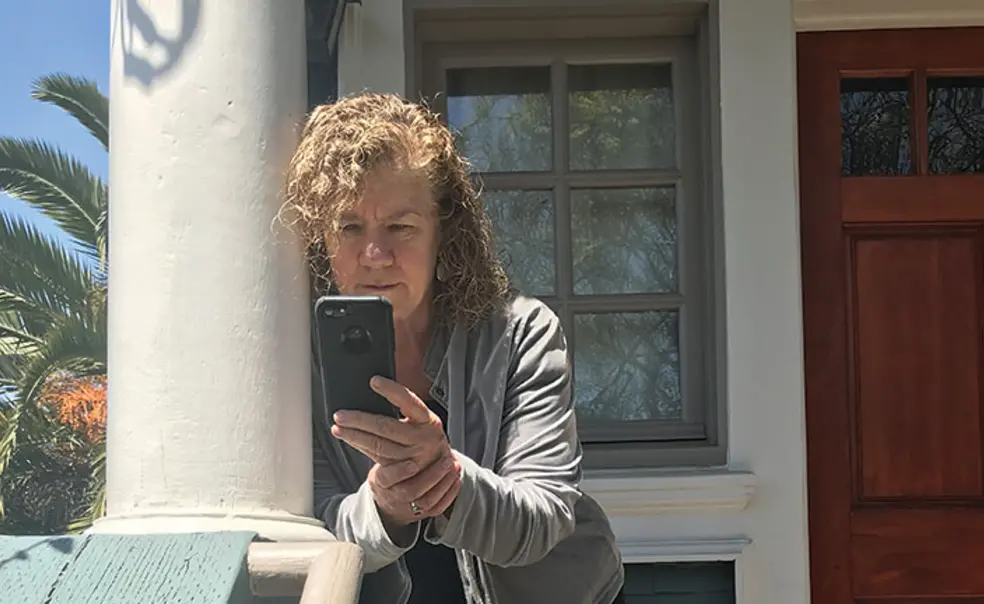Writer Constance Hale ’79 Learns to Live in Lockdown
“Humans are adaptive. We find ways to connect.”
Constance Hale ’79 is a California journalist and author.
It was a sunny Sunday afternoon in Oakland, and I was in my kitchen when my husband called to tell me to turn on the radio. “Gavin Newsom is speaking,” he said, elliptically. This was March 15. I was supposed to be in Salt Lake City, but I’d canceled the trip in what seemed like prudence verging on prudishness. “Social distancing” still sounded Orwellian. But teachers I knew were taking their classes online, my family had canceled plans to celebrate an uncle’s 80th, and we were washing our hands as often as possible. My poetry group had met earlier in the week, insisting on the verse while forgoing the usual potluck.
Yet here was Gov. Newsom, telling everyone over 65 to stay home. My husband, 71, hurried back from the hardware store, and we sat stunned. Then we started to strategize. I, 62, would become the gofer, errand-runner, grocery-shopper, interface to the world. We live in earthquake country, but we did not have a two-week supply of anything. We made a Costco list.
The next day, 6.7 million people in six Bay Area counties were told to “shelter in place.” The words jangled. I raced to Costco, donning nitrile gloves, wiping my shopping cart clean, and loading up, uncharacteristically, on salami, sausages, and frozen chicken. Never had I bought so many coffee beans and so much dried pasta. This wasn’t earthquake preparedness. We just didn’t want to have to go back to Costco.
The next step was to develop protocols. How we’d disinfect the house. What we would do when we went out for essentials. Who would and wouldn’t be allowed to visit. (In the end, no one.) The invisible threat, we were coming to understand, lurks everywhere — including in the people we bump elbows with, break bread with, trust, and love.
It hasn’t been natural for us to jump on Viber or hang out on Google. With friends of our vintage, we’ve enjoyed longer-than-usual phone calls. My greatest agony concerns my mother, 86, who lives in Hawaii, has difficulty hearing, and doesn’t much like talking on the phone. It strained our relationship when I harangued her about discontinuing her volunteer activities and giving up on chamber music. We struggle in conversations each night. I am saddened that I can’t keep her company through this.
But humans are adaptive. We find ways to connect. A colleague meets with her students via Skype. My writers collective uses Slack to stay in touch. Zoom takes us into our yoga teachers’ living rooms. Inspired by Italians singing from their balconies, some friends in Kensington are playing to neighbors from their deck.
I remember once hearing that Tiananmen Square made the fax newly relevant, and the Arab Spring proved the need for Twitter. This is the crisis that has made Slack, Skype, and Zoom not mere platforms, but lifelines.
With my mother, I’ve turned to FaceTime, so that she can read my lips. I walk around, showing her the veggie beds we’re planting and aiming the camera at my husband’s new deck, which, every day, is getting a little more built.
My half-Italian granddaughter turned 3 today. We read Dr. Seuss this morning on Viber. In the afternoon, I dropped off a Costco pizza and a present I’d wrapped with carefully washed hands, as well as ice cream and a disinfected, sealed package of balloons. I returned home, where a twin pizza was waiting. We connected on Messenger, baked our pizzas, ate, stuck candles in the ice cream, and sang “Tanti Auguri.”
PAW reached out to alumni who are on the front lines of the COVID-19 crisis or are affected by it in different ways. Read their essays here. More will appear in our next two issues and online over the next few weeks. Write to us at paw@princeton.edu with your own story.












No responses yet